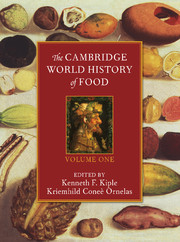Book contents
- Frontmatter
- Introduction
- Part I Determining What Our Ancestors Ate
- Part II Staple Foods: Domesticated Plants and Animals
- II.A Grains
- II.B Roots, Tubers, and Other Starchy Staples
- II.B.1 Bananas and Plantains
- II.B.2 Manioc
- II.B.3 Potatoes (White)
- II.B.4 Sago
- II.B.5 Sweet Potatoes and Yams
- II.B.6 Taro
- II.C Important Vegetable Supplements
- II.D Staple Nuts
- II.E Animal, Marine, and Vegetable Oils
- II.F Trading in Tastes
- II.G Important Foods from Animal Sources
- Part III Dietary Liquids
- Part IV The Nutrients – Deficiencies, Surfeits, and Food-Related Disorders
- References
II.B.4 - Sago
from II.B - Roots, Tubers, and Other Starchy Staples
Published online by Cambridge University Press: 28 March 2008
- Frontmatter
- Introduction
- Part I Determining What Our Ancestors Ate
- Part II Staple Foods: Domesticated Plants and Animals
- II.A Grains
- II.B Roots, Tubers, and Other Starchy Staples
- II.B.1 Bananas and Plantains
- II.B.2 Manioc
- II.B.3 Potatoes (White)
- II.B.4 Sago
- II.B.5 Sweet Potatoes and Yams
- II.B.6 Taro
- II.C Important Vegetable Supplements
- II.D Staple Nuts
- II.E Animal, Marine, and Vegetable Oils
- II.F Trading in Tastes
- II.G Important Foods from Animal Sources
- Part III Dietary Liquids
- Part IV The Nutrients – Deficiencies, Surfeits, and Food-Related Disorders
- References
Summary
Sago is an edible starch derived from the pith of a variety of sago palms, but mostly from two species of the genus Metroxylon – M. sagu and M. rumphii. The sago palms flower only once (hapaxantic) and are found in tropical lowland swamps. Other genera of palms that yield sago starch include Arecastrum, Arenga, Caryota, Corypha, Eugeissona, Mauritia, and Roystonea. In all, there are about 15 species of sago palms distributed in both the Old World and the New, with the most significant of these, M. sagu, located mainly on the islands of the Malay Archipelago and New Guinea. As a staple foodstuff, only the Metroxylon genus appears to be in regular use, generally among populations located in coastal, lacustrine, or riverine areas. Worldwide, sago provides only about 1.5 percent of the total production of starch and, consequently, is fairly insignificant as a global food source (Flach 1983). It is processed into flour, meal, and pearl sago, and is often used for thickening soups, puddings, and other desserts.
Sago starch is extracted in a variety of ways, although the general process is similar from area to area. The trunk of a felled palm is chopped into sections and then split vertically to allow the pith to be removed. The extracted pith is ground and then repeatedly washed and strained. The strained material is allowed to dry, and the result is pellets of sago starch. When processed in this manner, the average yield of one palm (of 27 to 50 feet meters in height) generally ranges between 130 and 185 kilograms (kg) of sago, which can feed a family of between two and four persons for up to three months.
History, Cultivation, and Production
History
The early history of sago palm use as a food is still unclear. Ethnologists and anthropologists have generally relied on native myths and legends to judge when it was introduced into the diets of many groups worldwide. Some, such as E. Schlesier and F. Speiser, have tended to believe that the sago palm has been utilized as a food source in the Pacific islands since prehorticultural days. J. B. Avé (1977), for example, has stated that Neolithic and Mesolithic artifacts found in insular Southeast Asia included tools used in sago preparation. Although this suggests that sago has been cultivated since ancient times, paleohistorians are not so sure. E. Haberland and others, for example, have contended that sago consumption was a postagricultural development (Ruddle et al. 1978).
- Type
- Chapter
- Information
- The Cambridge World History of Food , pp. 201 - 207Publisher: Cambridge University PressPrint publication year: 2000
References
- 1
- Cited by

